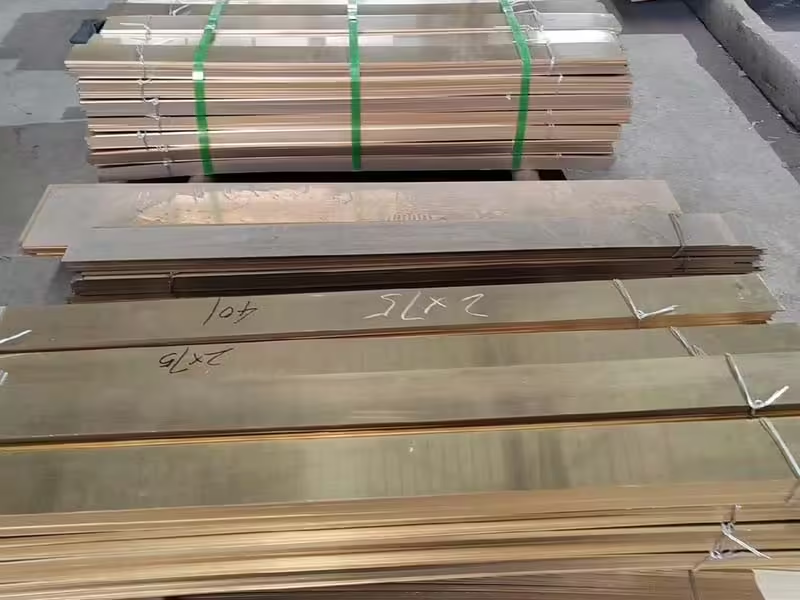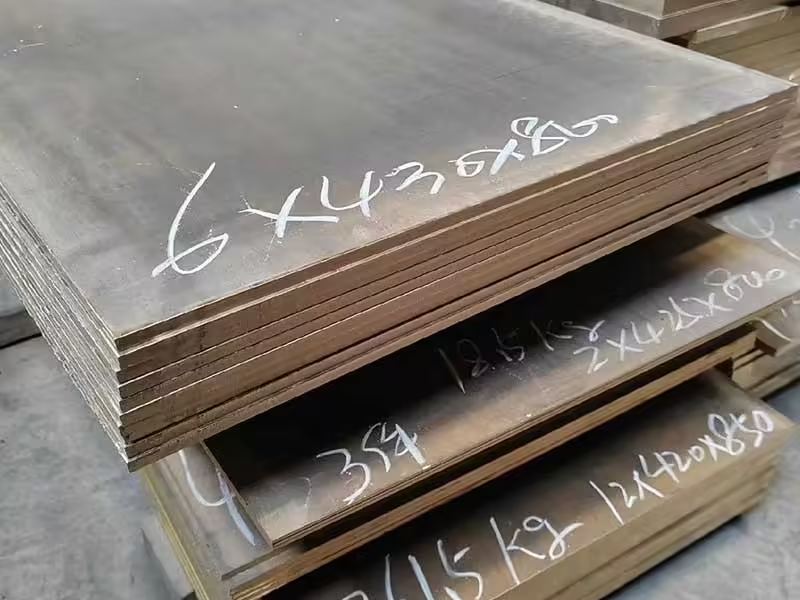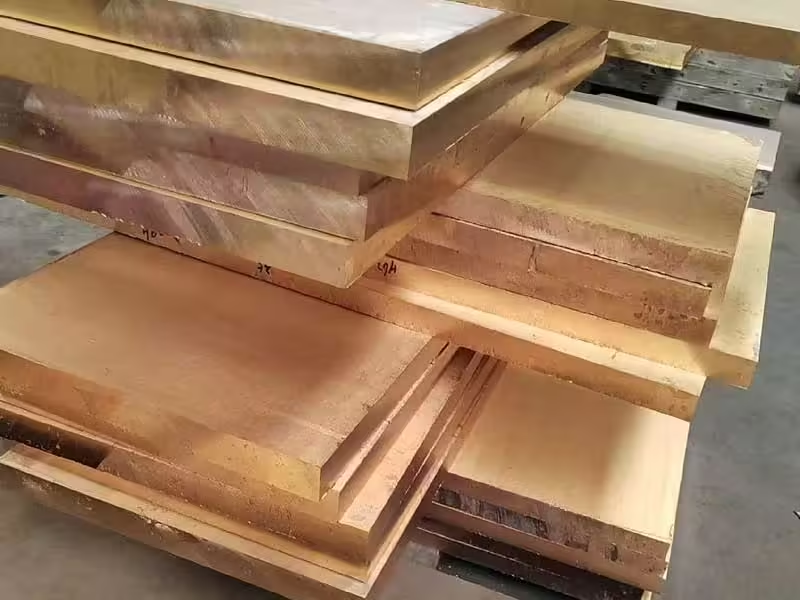내 블로그에 오신 것을 환영합니다!
본론으로 들어가기 전에, 제가 더 많은 정보를 공유하고, 커뮤니티와 소통하고, 업데이트를 게시하는 소셜 미디어 플랫폼에 함께해 주세요. 저와 소통하는 방법은 다음과 같습니다.
페이스북:https://www.facebook.com/profile.php?id=61571539990739
자, 이제 함께 여정을 시작해 볼까요? 여기 있는 내용이 통찰력 있고, 흥미롭고, 가치 있다고 느끼시기를 바랍니다.
목차
소개

동판은 일련의 야금 및 기계적 공정을 통해 생산되는 평평하고 얇은 구리판입니다. 높은 열전도율과 전기전도율과 같은 구리의 고유한 특성 덕분에 전기 배선, 열교환기, 지붕재, 장식 예술 등 다양한 분야에 활용됩니다. 동판 제조 공정은 구리 광석 채굴 및 정제를 시작으로 주조, 압연, 마감 공정을 거쳐 원하는 두께와 표면 품질을 얻는 방식으로 진행됩니다. 각 단계는 산업 표준 및 특정 용도 요구 사항을 충족하기 위해 세심하게 관리됩니다.
이 가이드는 원자재 추출부터 최종 검사에 이르기까지 주요 단계를 자세히 설명하여 동판 생산 과정을 명확하고 전문적으로 보여줍니다.
구리판이 어떻게 만들어지는지 이해하는 것이 중요한 이유
품질과 성능 보장
구리판의 제조 방식을 알면 제조업체와 최종 사용자가 해당 소재가 성능 기준을 충족하는지 확인하는 데 도움이 됩니다. 생산 공정은 전자, 배관, 건축 분야에 필수적인 전도성, 강도, 내식성과 같은 특성을 결정합니다.
지속 가능한 제조 지원
구리 산업은 지속가능성에 점점 더 집중하고 있으며, 재활용 및 에너지 효율적인 공정은 구리판 제조 과정에서 중요한 역할을 합니다. 이러한 관행을 이해함으로써 기업과 소비자는 구리 제품을 선택할 때 환경적으로 책임 있는 선택을 할 수 있습니다.
정보 자료 선택
엔지니어와 설계자는 구리판 제작 방식에 대한 지식을 바탕으로 두께, 합금 성분, 표면 마감 등을 결정합니다. 이를 통해 특정 용도에 맞춰 구리판을 제작하고 기능성과 내구성을 최적화할 수 있습니다.
구리판 제작의 주요 단계
구리 광석 채굴 및 정제
동판 제조 과정은 구리 광석 채굴에서 시작됩니다. 구리 광석은 일반적으로 황화물 또는 산화물 광상에서 발견됩니다. 채굴된 광석은 분쇄, 연마 과정을 거쳐 부유선별 또는 침출법으로 구리 정광을 추출합니다. 이 정광은 제련 및 정제 과정을 통해 고순도 구리(99.9% 이상)로 생산되며, 주로 음극 형태로 만들어져 동판 생산의 원료로 사용됩니다.
슬래브 주조 및 성형
정련된 구리는 용광로에서 용해되어 연속 주조 기술을 통해 큰 슬래브 또는 빌릿으로 주조됩니다. 이 단계에서는 불순물이 최소화된 균일한 구조가 보장됩니다. 슬래브는 냉각되어 추가 가공을 위해 준비되며, 이는 고품질 구리판 생산의 토대를 마련합니다.
열간 압연 및 냉간 압연
주조된 슬래브는 가열된 후 압연기를 통과하여 두께를 줄이는데, 이는 동판 제조 과정에서 매우 중요한 단계입니다. 열간 압연은 구리를 더욱 연성 있게 만들고, 후속적인 냉간 압연은 두께를 정밀하게 하고 표면 마감을 개선합니다. 여러 차례 압연기를 통과시켜 원하는 판재 두께(일반적으로 0.1mm에서 수 밀리미터까지)를 얻습니다.
어닐링 및 열처리
동판의 물성을 향상시키기 위해 압연된 동판을 가열한 후 천천히 냉각시키는 어닐링 공정을 거칩니다. 이 공정을 통해 내부 응력이 완화되고 연성이 향상되며 균일성이 확보되어 후속 가공에서 동판을 더욱 쉽게 다룰 수 있게 됩니다. 또한, 열처리는 특정 합금의 요구 사항에 맞춰 조정할 수도 있습니다.
표면 마감 및 절단
동판 제조의 마지막 단계는 표면 처리와 절단입니다. 동판은 원하는 외관과 내식성을 얻기 위해 연마, 세척 또는 코팅 과정을 거칩니다. 그런 다음 전단기나 레이저 절단기를 사용하여 정확한 크기로 절단하여 고객 사양을 충족하는 동판을 생산합니다.
동판 제조 공정 단계별 비교표
| 단계 | 목적 | 주요 장비 | 핵심 요소 | 도전 과제 |
|---|---|---|---|---|
| 채굴 및 정제 | 구리 추출 및 정제 | 분쇄기, 제련소, 정유소 | 고순도, 불순물 최소화 | 환경 영향, 에너지 사용 |
| 주조 및 성형 | 균일한 구리판을 만드세요 | 연속 주조기 | 구조적 일관성, 결함 없는 슬래브 | 냉각 속도 제어 |
| 열간 압연 및 냉간 압연 | 두께를 줄이고 표면을 다듬으세요 | 압연기 | 정확한 두께, 매끄러운 마감 | 균열 및 표면 결함 방지 |
| 어닐링 및 열처리 | 연성을 향상시키고 응력을 완화합니다. | 어닐링로 | 균일한 가열, 제어된 냉각 | 근력과 유연성의 균형 |
| 표면 마감 및 절단 | 최종적인 외형과 크기를 구현합니다. | 연마기, 절삭공구 | 표면 품질, 치수 정확도 | 일관성 유지, 폐기물 관리 |
이 표는 구리판 제조 과정을 단계별로 요약하여 장비, 주요 요소, 그리고 관련 과제를 강조하고 있습니다. 제조 공정의 복잡성을 이해하는 데 도움이 되는 참고 자료입니다.
구리판의 종류와 생산


순수 구리판
고순도 구리(99.9% 이상)로 제작된 순수 구리판은 전기 버스바 및 회로 기판과 같이 최대 전도성이 요구되는 용도에 적합합니다. 이러한 용도의 구리판 제조 공정은 불순물을 최소화하고 최적의 성능을 보장하기 위해 정련 및 압연 공정을 중점적으로 다룹니다.
구리 합금 판
아연(황동)이나 주석(청동)으로 만든 구리 합금판은 용융 단계에서 합금 원소를 첨가하여 제조됩니다. 이러한 합금판은 향상된 강도와 내식성을 제공하여 선박용 하드웨어나 장식용으로 사용됩니다. 합금용 구리판을 제작하는 방법에는 합금 조성을 정밀하게 제어하는 것이 포함됩니다.
얇은 구리판 vs. 두꺼운 구리판
구리판은 얇은 박판(0.5mm 미만)부터 두꺼운 판(수 밀리미터)까지 두께가 다양합니다. 얇은 판은 광범위한 냉간 압연 및 어닐링 공정이 필요하고, 두꺼운 판은 열간 압연 공정이 필요합니다. 구리판 제조 공정은 전자 제품이나 구조 부품 등 용도에 따라 달라집니다.
구리판 제작에 영향을 미치는 요소
원자재 품질
구리판 제조 과정에서 사용되는 구리의 순도는 매우 중요한 요소입니다. 고순도 구리는 우수한 전도성과 내식성을 보장하는 반면, 재활용 구리는 산업용으로 사용하기에 적합한 품질을 유지하기 위해 오염 물질을 제거하는 정밀한 정제 과정을 거쳐야 합니다.
제조 기술
연속 주조기 및 정밀 압연기와 같은 첨단 장비는 동판 제조 공정의 효율성과 정확성을 향상시킵니다. 자동화 및 실시간 모니터링을 통해 일관된 품질을 보장하고 불량률과 낭비를 줄입니다.
환경 규정
구리판 제조 방식에서 지속가능성은 핵심적인 고려 사항입니다. 제조업체들은 배출량을 최소화하고, 폐구리를 재활용하며, 에너지 효율적인 공정을 사용함으로써 환경 규정을 준수하고, 업계의 환경 발자국을 줄이기 위한 전 세계적인 노력에 발맞추고 있습니다.
구리판의 응용 분야
전자 및 전기 시스템
구리판은 전자 분야에서 주로 사용되며, 높은 전기 전도성 덕분에 회로 기판, 버스바, 배선 부품에 이상적입니다. 구리판은 정밀하게 제작되어 첨단 장치 및 배전 시스템에서 안정적인 성능을 보장합니다.
건설 및 건축
건축 분야에서 구리판은 내식성과 미적 감각 덕분에 지붕, 외장재, 배관 시스템에 사용됩니다. 구리판은 제작 과정에서 내구성과 성형성이 뛰어나 오래 지속되는 건축 자재로 선호됩니다.
산업용 열교환기
구리판은 뛰어난 열전도도를 자랑하여 HVAC 시스템, 발전소, 화학 공정의 열교환기에 필수적입니다. 구리판 제조 공정은 고온과 부식성 유체를 견딜 수 있도록 설계되었습니다.
장식적 및 예술적 용도
동판은 조각, 조형물, 장식 패널 등 예술 및 디자인 분야에서도 사용됩니다. 동판 제작 과정에서 표면 마감 처리를 통해 다양한 질감과 녹청색을 구현할 수 있어 창의적인 활용도를 높이고 시각적 매력을 더합니다.
구리판 제작 방법의 발전
자동화 및 정밀 제조
현대 구리판 제조에는 자동화가 도입되어 있으며, 컴퓨터 제어 압연기와 센서를 통해 두께와 표면 품질의 정밀성을 보장합니다. 이러한 발전은 구리판 제조 공정을 간소화하여 일관성을 향상시키고 생산 시간을 단축합니다.
지속 가능한 생산 관행
구리 산업은 최대 80%의 구리 스크랩을 재활용하고 제련 및 정제 과정에서 재생 에너지를 사용하는 등 더욱 친환경적인 방법을 채택하고 있습니다. 이러한 관행은 구리판 제조 방식을 혁신하여 환경 지속가능성 목표에 부합합니다.
합금 개발
구리 합금에 대한 지속적인 연구는 구리판의 응용 분야를 확대하고 있습니다. 강도, 항균성 또는 내식성이 향상된 새로운 합금이 개발되고 있으며, 새로운 산업 요구에 맞춰 구리판 제조 방식을 조정해야 합니다.
동판 관리 및 유지 보수

부식 방지
구리는 본래 부식에 강하지만, 적절한 관리를 통해 구리판의 수명을 연장할 수 있습니다. 정기적인 세척과 보호 코팅은 특히 실외 또는 해양 환경에서 변색을 방지하여 소재의 기능과 외관을 보존합니다.
표면 검사
긁힘, 움푹 패임, 산화 여부를 정기적으로 검사하여 구리판이 사용에 적합한 상태를 유지하도록 합니다. 초음파 검사나 육안 검사와 같은 비파괴 검사 방법을 통해 문제를 조기에 발견하여 구리판 제조 과정에서 달성된 품질을 유지합니다.
적절한 보관
구리판을 건조하고 습도 조절이 되는 환경에 보관하면 습기로 인한 부식을 방지할 수 있습니다. 산성 물질과 같은 호환되지 않는 물질과의 접촉을 피하면 보관 및 운송 중 구리판의 손상을 방지할 수 있습니다.
결론
동판 제조 공정은 첨단 기술, 야금 전문 지식, 그리고 지속 가능한 방식이 결합된 결과물로, 원료 구리를 전 세계 산업 분야에서 활용되는 다재다능한 소재로 변환합니다. 전자 제품부터 건축에 이르기까지, 동판의 전도성, 내구성, 그리고 미적 매력은 필수적인 요소입니다. 전문가들은 동판의 제조 과정, 종류, 그리고 적용 분야를 이해함으로써 이 소재를 효과적으로 선택하고 관리하여 프로젝트에서 최적의 성능을 보장할 수 있습니다.
자동화와 친환경 혁신을 통해 제조 방식이 계속 발전함에 따라, 동판 제조 방식은 기능성과 지속가능성을 모두 뒷받침하는 산업 발전의 초석으로 남을 것입니다.
자주 묻는 질문
구리판은 어떤 원자재로 만들어지나요?
주요 재료는 구리 광석이며, 고순도 구리 음극(99.9% 이상)으로 정제됩니다. 용도에 따라 구리 합금판에 아연이나 주석과 같은 합금 원소를 첨가할 수 있습니다.
구리판을 만드는 데 가장 중요한 단계는 무엇입니까?
열간 압연과 냉간 압연 모두 구리판의 두께, 표면 마감 및 기계적 특성을 결정하는 중요한 공정입니다. 이 단계에서의 정밀도는 품질과 일관성을 보장합니다.
전자용과 건축용 구리판의 차이점은 무엇입니까?
전자 제품의 경우, 구리판은 전도성을 위해 고순도 구리와 얇은 치수로 만들어지는 반면, 구성용 판은 내구성과 미관을 위해 합금과 두꺼운 형태를 사용할 수 있습니다.
구리판을 만드는 데 환경적 문제가 있습니까?
채굴과 제련은 환경에 영향을 미칠 수 있지만, 폐구리 재활용 및 에너지 효율적인 공정 사용과 같은 현대적인 방식은 구리판 제조 과정에서 이러한 우려를 완화합니다.
구리판은 어떻게 만들어질 때 품질이 보장되나요?
정밀한 정제, 주조, 압연 및 마감 공정 관리를 통해 품질을 유지하며, 각 단계에서 순도, 두께 및 표면 품질에 대한 검사와 테스트를 실시합니다.

